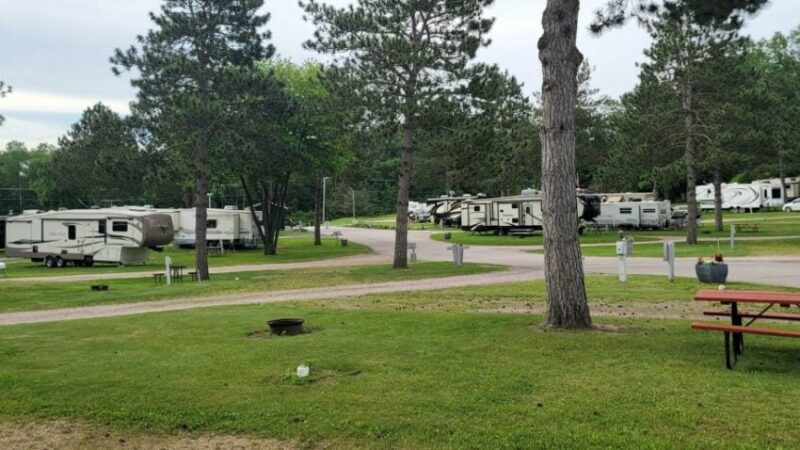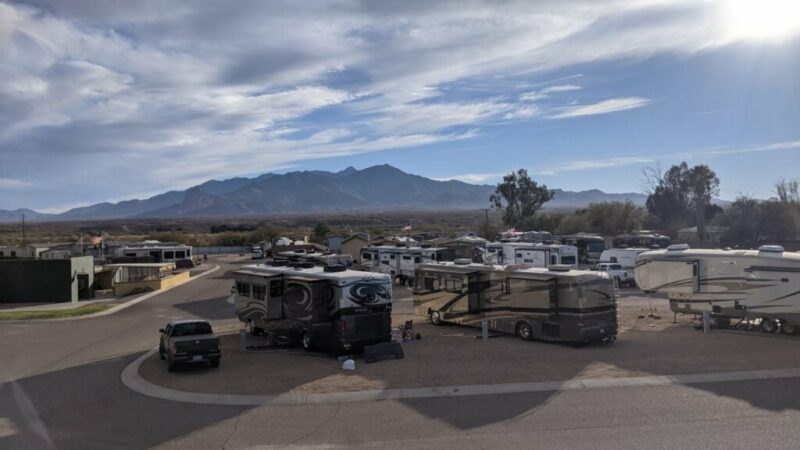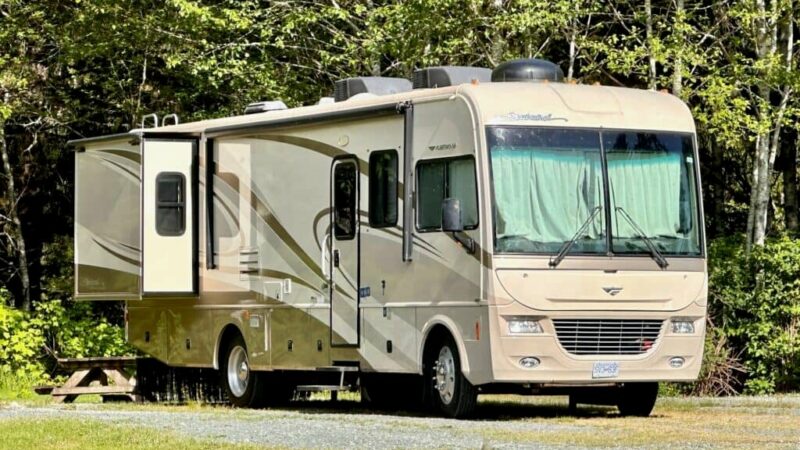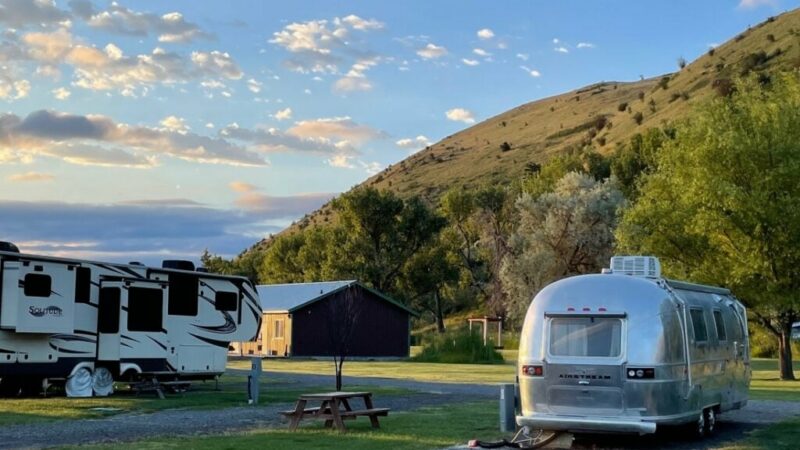Long-Term RV Storage: What Are Your Options?
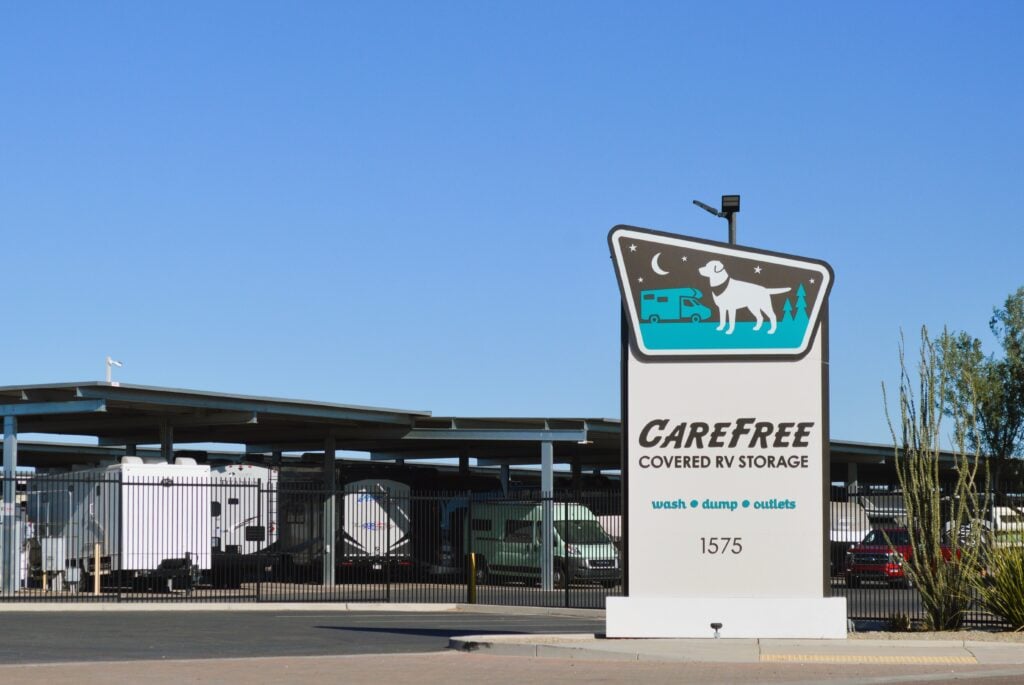
How To Find Long-Term RV Storage For The Off-Season (And Beyond)
Although some RVs can be used all year round, most people only use them during the warmer months. Once winter rolls around, you need a safe place to store your vehicle until the next time you’re ready to take a trip. Because so many people need long-term RV storage, there are several different options available.
Different storage methods come with their own pros and cons. Some are low-effort yet expensive. Others are cheap but require a lot of work! It all depends on how much you want to spend, how much effort you want to put in, and what type of security/protection you’re looking for.
Some of the most common long-term RV storage options include enclosed storage facilities, covered parking spaces, outdoor lots, campground rental spaces, or at-home options. Any of these options can work. It just depends on which route makes you feel the most comfortable! We’ll explore each of these storage choices below so you can make a more informed decision.
Enclosed storage facility
This first option is usually the most expensive. Enclosed RV storage facilities are exactly what they sound like! These are large garages or warehouse-like buildings where multiple RVs can be stored. They are fully enclosed, so they protect RVs from the elements, as well as vandals, pests, and other potential dangers.
Best of all, these facilities usually maintain steady temperatures and humidity levels. Exposed RVs are at risk of rusting, UV damage, exploded pipes, and more. They’ll be safer in this controlled environment. Most facilities also have heavy security and cameras, so you can rest assured that nobody will mess with your vehicle while it’s in storage.
On the downside, enclosed storage facilities cost a lot of money. Some options can cost hundreds of dollars per month, with the most expensive ranging up to $450. Of course, this price is on the higher end, but it’s not unheard of. If you want to use these facilities for long-term RV storage, you need to be prepared to pay hefty fees!
Covered parking spaces
Another commercial option would be covered parking spaces. These don’t provide the same level of protection as an indoor facility but they’re still better than nothing! Covered RV storage gives you a sturdy roof overhead. It may even have additional walls to protect the vehicles from wind, rain, and snow.
When your RV is covered, there’s a lower chance that damage could occur. For instance, snow won’t pile up on the roof and weigh it down. Additionally, it will be protected from UV radiation.
However, there are a few downsides to this storage style. Because these parking spaces are open-air, there’s still a way for pests to invade your camper. Humidity and temperature fluctuations could also cause problems. Dirt, pollen, and other airborne debris can taint the exterior as well.
It’s not a perfect solution, but it’s much cheaper when compared to an indoor facility. These covered spaces are also guarded and monitored by cameras, so that should provide some peace of mind.
Outdoor parking lot
A more cost-effective form of long-term RV storage would be an outdoor parking lot. There’s little to no protection from the elements, but it lets you get the RV off your property for a few months.
These outdoor parking lots are usually surrounded by fences, but beyond that, security is often minimal. Therefore, there’s a higher risk that your RV might be burglarized or vandalized.
Make sure to remove all your valuables before putting them in storage. The vehicle will also be exposed to wind, snow, rain, sun, and all the dirty parts of the outdoors. Using a high-quality cover can help you avoid the worst of it.
Outdoor parking lots are one of the cheapest commercial solutions. If you want to store your RV for a long time (especially if it’s an older model), this could be a good, low-cost solution.
Resort/Campground storage
Although you can always store your camper in a private facility, you might also want to look into the storage options that campgrounds and resorts provide. Many high-end resorts cater to year-round residents. To increase their appeal, they sometimes offer long-term RV storage for residents who live in park models or rentals.
The quality and storage capacity of these facilities varies wildly. Some parks may only have space for a few vehicles, while others can host hundreds of models!
In general, campground and resort storage options are enclosed and temperature-controlled. They cost more as a result, but you can rest assured that your RV is well-protected. Covered parking spaces and carports are also common.
This type of service is uncommon but not unheard of. Make sure you do plenty of research when you pick out a long-term resort to stay at. You may be able to get a good deal on a storage facility if they provide that service.
At-home storage
Finally, you could choose to save money and keep your RV at home. This is the cheapest option because you don’t have to pay anyone else to look after your camper during the offseason.
It does require the most amount of work, though. You’re responsible for maintaining your RV, protecting it against the weather, and checking for pests and damage. It can also be a hassle to work around these large vehicles because they take up so much space. You will also need to be aware of any HOA rules and local regulations that may apply.
With that being said, there are three main options for at-home storage.
Garage
If it’s realistic for your circumstances, a garage is the best way to store an RV for long periods of time. It’s fully enclosed, which makes it easier to regulate the temperature and humidity.
Unfortunately, many people cannot store their RVs in garages because they take up too much space. These vehicles are generally too large to fit inside standard garages. Unless you have a special RV-sized space, you’ll need to use an alternative method.
Carport
Carports are another decent option you could try. It’s fairly easy to build or install one that’s big enough to cover an RV. It also protects the roof from most of the elements. They’re still open to the air, though, so you’ll need to be vigilant about maintenance.
Carports are the best middle-ground option for those who want to keep their RV at home. They’re pretty cheap, easy to set up, and they provide a bit of extra protection. If you have space for this type of covered storage, we recommend this route.
Open-air storage in the driveway/backyard
Lastly, depending on where you live, you may be able to store your RV in your driveway or backyard. This option provides little to no protection, but it is quite cheap. If you opt for open-air storage, you should always cover your RV with a protective layer. RV covers come in many shapes and sizes.
We recommend that you invest in a high-quality product because the cover will be your only line of defense against the elements. The King Bird Upgraded RV Cover is a wonderful all-purpose option. You can also protect the wheels with covers and use an inflatable pad to seal the gap beneath the camper.
Before you store your RV, make sure you winterize your RV and remove all food and perishable items. Anything edible can attract pests. You also need to drain your holding tanks, remove the battery, and do everything you can to reduce moisture/humidity. A bit of extra work will go a long way!
Make sure you keep track of all your RV maintenance and repairs with an online tool such as RV LIFE Maintenance. Not only can you keep all of your documents in one place, but you’ll also receive timely reminders when maintenance is due to help you avoid costly repairs and potentially serious accidents.
Related articles:
- Is 5-Star RV Storage Worth The Money?
- A Complete RV Winterizing Checklist
- Covered RV Storage vs Motorhome Covers: What’s Best?
The post Long-Term RV Storage: What Are Your Options? appeared first on RV LIFE.




